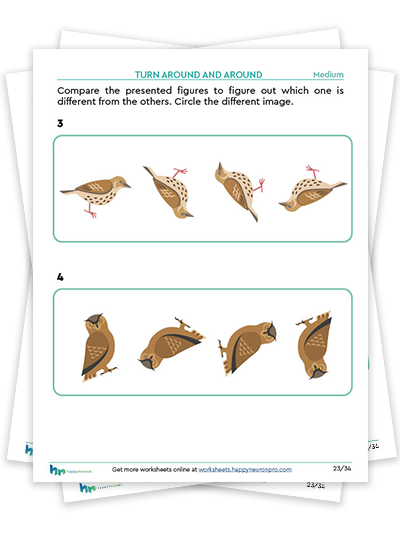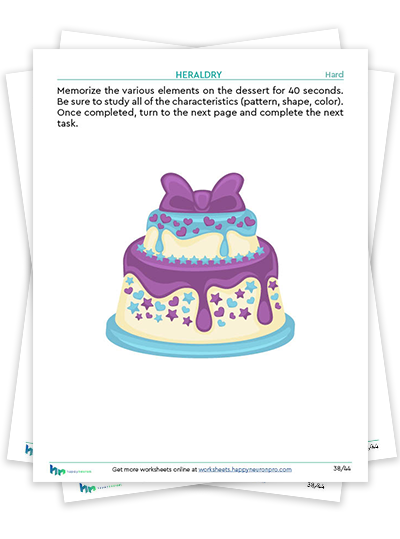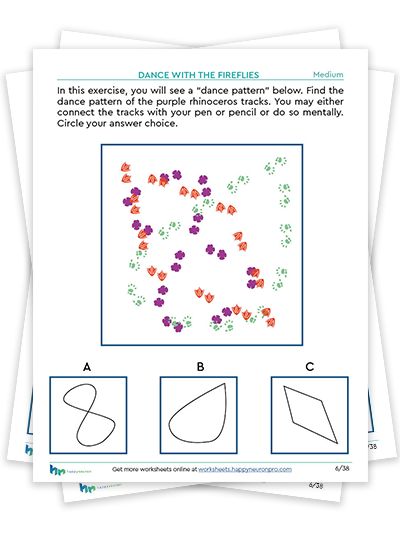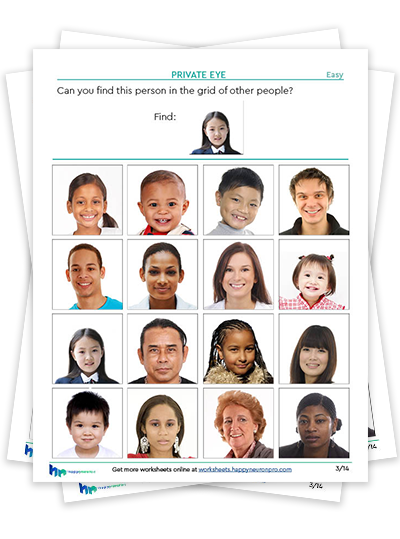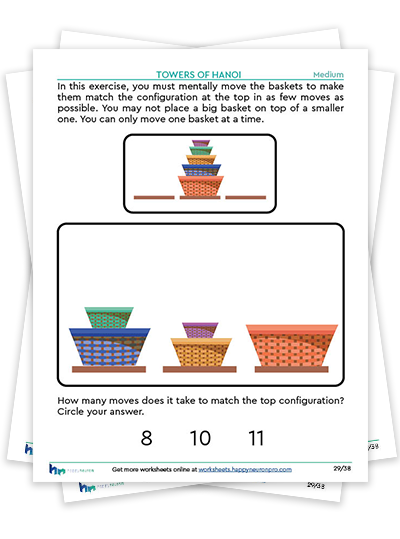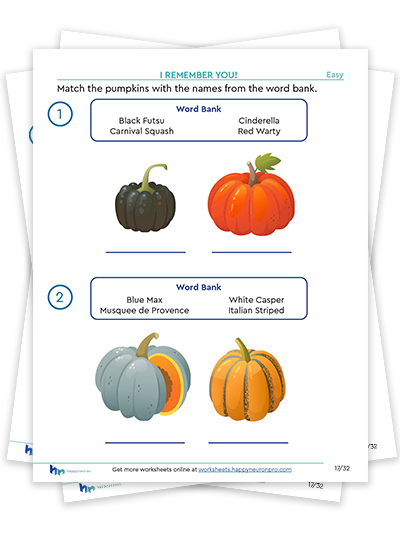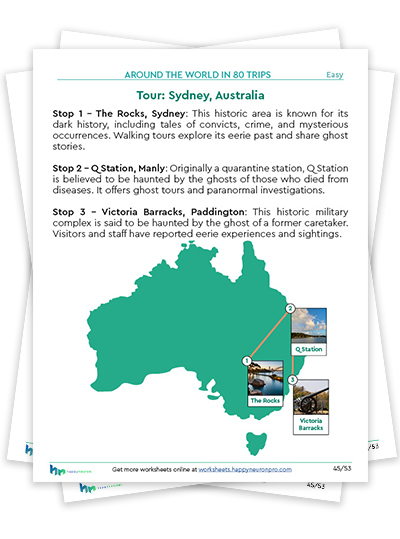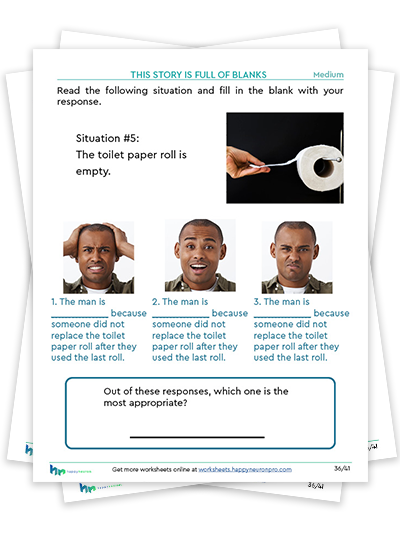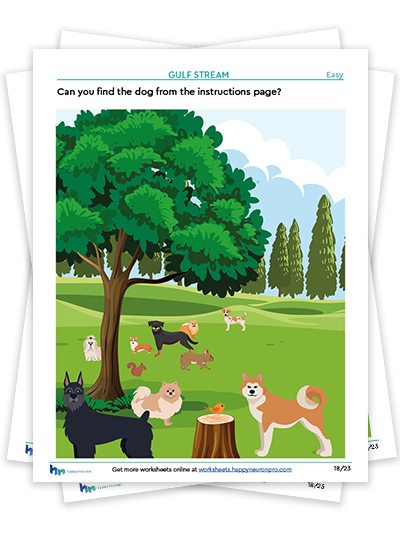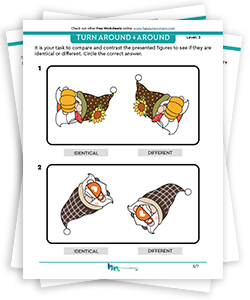Packets
Packets
Scientifically Designed Worksheets
These packets include at least 4 different exercises with each having several difficulty settings and bridging activities. Each packet focuses on a cognitive function, a medical condition, or a theme.
We release a new packet once per month and you can subscribe to get them directly in your inbox.
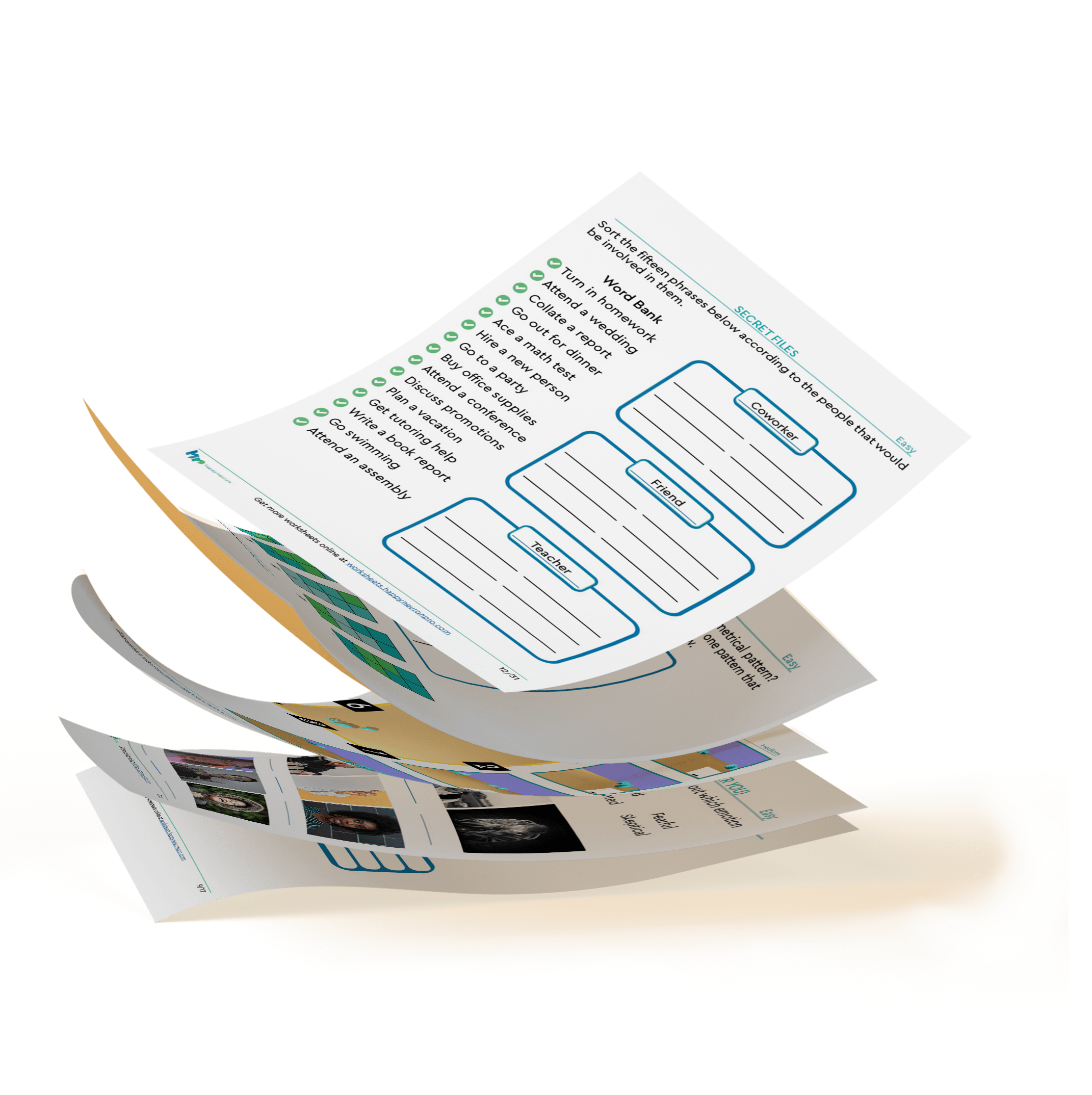
Filters
Memory
Language
Attention
Processing speed
Visual-spatial
Executive functions
Social cognition
Math and computational
Kids
Hybrid
Themed
Not purchased yet
Sort by
Embrace the sunny season while working on your cognitive abilities with our summer-themed cognitive exercise packet! This collection of fun executive function activities is designed to help you practice verbal and visual memory, as well as planning skills. Inspired by some of our engaging digital exercises, this packet of planning worksheets provides a comprehensive mental workout with a summer vacation twist.
The Right Count: Sharpen your arithmetic skills by ordering numbers in ascending or descending order. This activity challenges your planning abilities and helps you develop a keen sense for numerical sequences.
Embroidery: Hone your verbal memory and attention to detail by finding a hidden word within a grid of letters. This task is perfect for working on verbal recall and visual scanning skills.
Hurray for Change: Take on the dual challenge of ordering numbers and letters simultaneously. This exercise boosts your ability to multitask and enhances both numerical and alphabetical ordering skills.
An American in Paris: Work on visual and verbal memory by memorizing trips using images and location names. This activity is great for working on memory and strategy skills.
Ideal for individuals recovering from a brain injury and looking to improve daily cognitive functions, seniors who want to engage in stimulating activities, or students looking to exercise critical thinking, memory retention, and organizational skills.
What is inside: 41 unique planning worksheets and bridging questions.
Unlock the power of executive functions —explore our full library of executive function worksheets today! →
Explore a town like never before with these engaging spatial memory worksheets, turning a bike ride into an exciting cognitive adventure! This comprehensive packet is inspired by four of our popular digital exercises, each crafted to enhance specific cognitive skills.
Start with “Catch the Ladybug,” a delightful activity that works on visual attention and spatial awareness as you spot various items on the page. Then, move on to “Dance with the Fireflies,” where you’ll hone your attention and spatial reasoning by following mesmerizing tangled patterns.
Challenge your mind further with “Turn Around and Around,” an exercise that sharpens your mental imagery and rotation abilities. Visualize objects from different angles and improve your ability to manipulate them in your mind’s eye. Finally, navigate through “Find Your Way,” a task that focuses on strengthening your spatial memory as you memorize and recall intricate pathways.
This packet is meticulously designed to exercise a range of cognitive skills, including attention, spatial reasoning, memory, and planning. Whether you’re an adult or senior looking to keep your mind sharp, or an adolescent seeking a challenge, these exercises offer an enjoyable and cognitively stimulating experience.
What is inside: 38 unique attention and spatial memory worksheets and bridging questions.
Unlock the power of spatial skills —explore our full library of visual-spatial worksheets today! →
Embark on a semantic memory adventure with our comprehensive packet featuring 42 unique language activities. This packet is designed to stimulate various forms of semantic memory. Whether you’re looking to challenge spatial and verbal memory or enhance word recall and comprehension, this packet offers various engaging exercises to elevate cognitive skills.
Begin your journey with “Words, Where are You?”—an activity that tests spatial and verbal memory by prompting you to recall words and their locations on a grid. This serves as a warm-up to prepare your semantic memory for the challenges ahead. Next, dive into “Root it Out,” where you’ll challenge your ability to recall words through specific tasks, providing a fun and effective way to stimulate semantic memory.
Continue your exploration with “Split Words,” a puzzle activity that encourages you to connect broken words. This may foster connections and stimulate visual semantic memory. Lastly, immerse yourself in “This Story is Full of Blanks,” an expressive semantic memory exercise in which you fill in missing words from a word bank to complete the story or poem.
While some activities may require higher language functions, individuals of varying ages and cognitive abilities can benefit from this packet. While younger individuals may find certain tasks challenging. We believe that a 7th grader could successfully complete all activities with guidance and support. Adults of all ages and abilities should enjoy these activities. Your senior clients will have fun completing these challenges.
What is inside: 42 unique semantic memory activities and bridging questions.
Unlock the power of language and memory—explore our full library of language worksheets today. Embark on a journey of cognitive discovery! →
Embark on a journey through the enchanting world of birds with our “Bird Watching” cognitive worksheet packet. This carefully crafted, science-based packet is designed to engage learners of all ages in a captivating exploration of avian wonders while honing essential skills with fun visual-spatial worksheets.
Skill Development:
Sharpen visual-spatial skills such as mental rotation, spatial reasoning, and left-right orientation through hands-on exercises and puzzles. This packet is designed to help users strengthen their ability to visualize spatial relationships, mentally manipulate shapes, recognize patterns, distinguish left from right, and navigate directional cues in a fun and engaging manner. The exercises that work on these skills are pulled directly from our digital program. Learn more about these cognitive exercises – Ancient Writing, Sleight of Hands, Turn Around and Around, and The Squeaking Mouse.
Benefits:
- Designed to enhance visual-spatial skills essential for daily functioning and academic success.
- Promotes cognitive development through engaging and interactive activities.
- Fosters a deeper appreciation for nature and wildlife while learning about birds and other animals.
- Provides a fun and enjoyable learning experience for users of many ages and abilities.
- Supports therapy goals related to spatial awareness, attention, and problem-solving skills.
Fun and Engaging Activities:
With our “Bird Watching” cognitive worksheet packet, learning becomes an immersive and enriching experience, blending the fascination of bird watching with the cognitive benefits of visual-spatial skill development.
Included inside: 28 pages of fun visual-spatial worksheets plus bridging questions.
Grab your binoculars and join us on this thrilling adventure – birds and other amazing animals are waiting to be discovered! Explore our collection of visual-spatial worksheets and embark on a journey of cognitive growth today →
Transform your boring visual attention and concentration worksheets into a delectable delight with our engaging baking-themed worksheet collection. This baker’s delight assortment is meticulously crafted to invigorate visual attention and concentration skills, promising an enjoyable challenge for individuals of all ages.
Savor the Sweetness:
Indulge in the irresistible allure of our baking-themed worksheets, where each exercise is a flavorful journey through visual attention and concentration. From cupcakes to donuts and beyond, the delightful imagery stimulates engagement and focus, making every activity a treat for the senses. Dive into our digital exercise, Shape and Colors with a cupcake theme! Challenge your client with Displaced Images of donuts, and unravel the Entangled Figures of stacked desserts. Culminate your experience with a compelling adaptation of Heraldry, where pies take center stage in a test of visual attention.
Suitable for All Ages:
From the youngest sprinkle-lover to the seasoned cream connoisseur, this worksheet set promises joy and engagement for all ages. Whether you’re giggling over sprinkles or reminiscing over cherished dessert memories, each activity fosters delightful interactions with the material. For seniors needing a cognitive pick-me-up, these worksheets offer a delightful opportunity to indulge in thoughts of their favorite treats.
Included inside: 40 visual attention & concentration activities and bridging questions.
Elevate your cognitive experience with the flavorful charm of our baking-themed worksheets. Engage your senses, sharpen your concentration, and create sweet memories with each delightful activity. Explore our collection of attention worksheets and embark on a journey of cognitive enrichment today →
Set your students on an exciting animal-tracking adventure with our specially crafted focus attention activity packet! In this engaging journey, students will immerse themselves in a series of tasks designed to enhance their focus and attention skills.
Attention-Captivating Tasks:
The adventure begins as students decipher the intricate patterns animals leave in a field of tracks. With keen observation, they’ll identify the odd pawprint in a displaced character activity and the dance with fireflies, challenging their attention to detail. Next, spatial memory takes the spotlight as they recall the precise locations of each animal on the grid. The journey concludes with a test of divided attention skills – listening to words and categorizing animals on the screen demands concentration and focus.
Versatile for All Ages:
This attention activity packet is not just limited to a specific age group; it’s suitable for students of all ages! Animal enthusiasts will find joy in honing their focused attention skills, and teachers can seamlessly integrate these activities to help students refocus after outdoor play or any energizing activity.
Included inside 38 Unique, focused activities, 3 videos for divided attention, and bridging questions.
If the animal tracking adventure captivates your students’ attention, explore our library of attention activities for more engaging challenges. Elevate focus and cognitive skills with our diverse collection!
Transform focus-building into an enjoyable exploration with our attention activities for students. Unleash the potential for enhanced attention and concentration while making learning a delightful adventure. Check out our other attention activities for a continuous journey of focus and skill development →
Elevate your visual memory and refine your facial recognition abilities with our Matching Faces Packet. This comprehensive collection is expertly designed to be an engaging visual memory exercise, offering an enjoyable challenge for individuals of all ages.
Key Features:
- Matching Faces for Visual Memory Mastery:
- Immerse yourself in the captivating world of facial recognition by mastering the art of matching faces within this thoughtfully crafted packet.
- Strengthen your visual memory as you train your mind to identify and remember unique facial features.
- Versatile for All Ages:
- Suitable for a diverse audience, from children honing essential cognitive skills to adults looking to sharpen their memory prowess through the art of matching faces.
- In fact, this is ideal for clinicians, parents, educators, and individuals seeking an enjoyable yet impactful visual memory challenge.
What’s Included in Our Matching Faces Worksheets:
- The Right Person in a Crowd: Hone your ability to find a face in a crowd by trying to locate the target person in a grid of people. Private Eye has a fun social cognition element and is a great way to warm up your cognitive abilities.
- Remembering your Friend: Immerse your client in this visual memory task as they have to find all of the matches of faces from memory. This printed version of Gulf Stream shows how practicing the digital exercise may help your client’s visual memory skills.
- Order’s Up: Another life skill experience has entered the pages of this workbook. The restaurant again has a human factor to it! We hope your client starts to see the real-life bridging between the digital tool and real life.
- Bird Song: Lastly, dive into your auditory memory box as your clients listen to conversations and answer questions..
Included inside: 40 visual & social memory activities and bridging questions.
In fact, if you like this packet, explore our other social cognition worksheets →
Enjoy the final harvest of the year with this fun executive function strategy worksheet packet! These executive functioning activities are fall harvest-themed to help bridge the world of worksheets to the working world. Our scientifically based executive functioning activities are a fantastic choice for both children and adults.
What’s Included in Our Fall-Themed Language Worksheets:
- Count the Harvest: Exercise your counting ability by sorting baskets full of different fruits in this printable version of The Right Count. This exercise is the perfect warm-up to start all of the calculating functions in your client’s brain.
- Categorizing Words: A critical component of executive functioning is the ability to categorize. Immerse your client in this fun language-based strategy activity as they complete this printable version of Secret Files.
- Points of View: A printed version of our digital tool, have your client practice figuring out where they are in space by using the points of view.
- Towers of Hanoi: Lastly, practice holding images in your mind as you strategize how you are going to move the pieces around.
Why Choose Our Executive Function Strategy Worksheet Packet #57?
- Professionally designed for a fall-inspired experience.
- Suitable for all ages, from kids (13+) to adults.
- High-quality, printable PDF format.
- Instant download so you can begin your fall journey right away.
Included inside: 30 strategy worksheets and bridging questions.
In fact, if you like this packet, explore our other executive functioning worksheets →
Get ready for a delightful autumn experience with our Printable Fall Language Worksheets! These captivating scientifically based language-based activities are adorned with charming fall themes, making them a fantastic choice for both children and adults. These activities are perfect for spicing up your fall celebrations, adding educational fun to classroom settings, or bringing extra warmth to group therapy sessions.
What’s Included in Our Fall-Themed Language Worksheets:
- The Right Alphabet: Exercise your language skills by sorting this language adapted from our digital exercise, The Right Count. This exercise is the perfect warm-up to start all of the language functions in your client’s or students’ brains.
- Fall Fables Pieced Together: Immerse your client in delightful fall words as they have to fix the fragments in this printable version of Splitwords.
- Pumpkin Carving Memory: A real-life experience has entered the pages of this workbook. We’ve adapted Restaurant to be a pumpkin carving for customer edition.
- You’ve Got Voicemail: Lastly, dive into your voicemail box as your clients read messages from their friends and answer questions about their plans.
Why Choose Our Printable Fall Language Worksheets:
- Professionally designed for a fall-inspired experience.
- Suitable for all ages, from kids to adults.
- High-quality, printable PDF format.
- Instant download so you can begin your fall journey right away.
- Reusable for autumn-inspired learning year after year.
Included inside: 28 fall-themed language worksheets and bridging questions.
In fact, if you like this packet, explore our other language worksheets →
Prepare for a ghoulishly good time this Halloween with our Spooky Verbal Memory Printable Worksheets! These engaging and fun activities are perfect for kids and adults alike, making them ideal for Halloween parties, classroom activities, or family gatherings.
What’s Included:
- Wicked Word Match: Challenge your memory skills by matching spooky-themed words in this printed version of Displaced Characters.
- Eerie Memory Haunts: Study these spooky words and where they are on the grid. Next, place the appropriate where you saw the words. Who knew? Words, Where are You could make you feel haunted!
- Haunted Stories Parts of Speech Memory: Test your verbal recall with these Halloween-themed stories.
- Plan a Haunted Trip: Study a trip that visits real-life haunted places worldwide! Visit the homelands of all of our customers in this fun Around the World in 80 Trips activity.
👻 Why Choose Our Spooky Verbal Memory Worksheets 👻
- Professionally designed for Halloween fun.
- Suitable for all ages, from kids to adults.
- High-quality, printable PDF format.
- Instantly downloadable, so you can start the Halloween fun right away.
- Reusable for endless enjoyment year after year.
Included inside: 49 spooky verbal memory worksheets and bridging questions.
If you like this packet, explore our other memory worksheets →
Are you looking for worksheets to be used in your identifying emotions activities? Then look no further! We’ve adapted our digital exercises to help you strengthen your client’s ability to identify and express emotions. Key features of this packet are:
- Emotion Recognition: Practice recognizing emotions at a glance. We’ve adapted our digital exercise, Ancient Writing, to use modern emotion-based emojis instead. Your client will have to read the emotions and identify which one does not belong.
- Expressive Vocabulary Building: This packet encourages exploring and incorporating diverse emotional words. Whether you’re seeking to expand your vocabulary or assist others in doing so, these exercises provide an enjoyable pathway. I Remember You is now into I Understand Your Emotions.
- Working Memory Recall: Can you recall the faces of different emotions at a moment’s notice? In contrast to typical n-back exercises, this packet has a series of emojis instead of colors or letters. This exercise would work great in this packet or on its own as a warm-up.
- Situational Response Practice: Elevate your client’s interpersonal interactions with informed emotional responses! Your client will have to engage in scenario-based activities that encourage thoughtful consideration of appropriate reactions to different emotional situations. Start to develop the ability to navigate conversations and relationships with empathy and grace.
Dive into the world of emotional vocabulary, recognition, memory reinforcement, and responsive communication with our Emotion Identification Worksheet Packet. Experience the transformational power of emotional intelligence today! Unlock the potential of emotions as you’ve never done before! Teachers, enrich your classroom with this packet and teach your students about emotional intelligence. Parents, start conversations with your kids about emotions. And lastly, therapists empower your clients to think about their emotions and maybe even enhance their understanding of emotions. We recommend this packet for any age who can identify emotions.
Included inside: 36 emotion worksheets and bridging questions.
If you like this packet, explore our other social cognition worksheets →
Who let the dogs out!? Seriously, who let the dogs take over this attention worksheet? If you are looking for a great dog-themed attention worksheet, then look no further. This packet works on all major areas of attention but with a fun dog twist. Your client will have fun engaging their visual attention skills, their visual-spatial skills, and their ability to follow complex paths. Visual attention is an essential element of cognitive functions, we know that not every activity on the internet is fun and engaging. That is why we developed this fun packet to work on visual attention skills. This packet has the following exercises: Displaced Images, Gulf Stream, Dance with the Fireflies, and entangled figures.
If you enjoy these worksheets, make sure to try the digital versions of the exercises. We recommend this packet for all ages. We believe adults will benefit as much as a preschooler will as they practice this packet. We personally think the Dance with Fireflies, a dog walking path edition, is a fun way to practice working memory, visual attention, and spatial reasoning. Let us know what you think of this dog-themed attention worksheet!
Included inside: 31 worksheets and bridging questions.
If you like this packet, explore our other attention worksheets →



